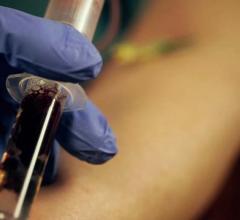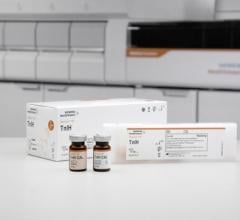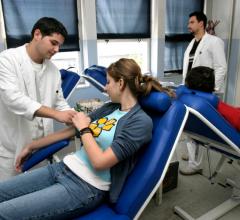
The Alere Triage Troponin I Test is a fluorescent next-generation immunoassay, to be used with the point-of-care Alere Triage MeterPro, for quantitative measurements of troponin I.
Hospital-based healthcare providers today are under greater pressure than ever to administer cost- and time-efficient cardiac care that directly enhances patient outcomes. A critical strategy for achieving these goals is the utilization of rapid point-of-care (POC) diagnostics.
Although the benefits of POC cardiac testing have been well documented, many hospitals still use central workstations to process tests or input results, and this approach is far from optimal. Centralized testing delays results — preventing physicians from making the most informed treatment decisions in an actionable timeframe — creates efficiency-sapping bottlenecks and drives up healthcare costs.
Speeding Triage of Cardiac Patients
Rapid POC cardiac testing platforms address these issues by facilitating accurate evidence-based diagnostic and triage decisions. These tests provide critical results more easily and quickly, empowering staff to identify those patients at greater risk for complications, administer appropriate treatment sooner and help optimize health outcomes. In studies of chest pain patients, POC testing of troponin I and other cardiac markers was associated with significant decreases in time spent in the emergency department (ED) and in the hospital, and increased rates of successful discharge, versus central laboratory testing.[1, 2]
 Today’s rapid POC tests enhance the assessment of many critical markers. By testing markers such as BNP, troponin I and D-dimer at the point of care, for example, physicians can quickly differentiate acute myocardial infarction from other cardiac abnormalities. A handheld blood gas/electrolyte/metabolites (BGEM) analyzer significantly streamlines testing — delivering results in about three minutes versus up to two hours for portable and central analyzers. Testing natriuretic peptides (BNP and NT-proBNP) can help confirm a clinical diagnosis of heart failure in patients presenting in the urgent care settings. This is now recommended in the latest American College of Cardiology and American Heart Association (ACC/AHA) clinical guidelines for chronic heart failure. And, rapid tests can help keep patients from being hospitalized in the first place, such as home INR tests that help reduce adverse events among warfarin patients.[3]
Today’s rapid POC tests enhance the assessment of many critical markers. By testing markers such as BNP, troponin I and D-dimer at the point of care, for example, physicians can quickly differentiate acute myocardial infarction from other cardiac abnormalities. A handheld blood gas/electrolyte/metabolites (BGEM) analyzer significantly streamlines testing — delivering results in about three minutes versus up to two hours for portable and central analyzers. Testing natriuretic peptides (BNP and NT-proBNP) can help confirm a clinical diagnosis of heart failure in patients presenting in the urgent care settings. This is now recommended in the latest American College of Cardiology and American Heart Association (ACC/AHA) clinical guidelines for chronic heart failure. And, rapid tests can help keep patients from being hospitalized in the first place, such as home INR tests that help reduce adverse events among warfarin patients.[3]
Simplicity in Testing
Rapid POC cardiac diagnosis offers other important benefits as well. Today’s tests are designed for use by a wide range of providers — not just lab technicians — and many require minimal training. They reduce analysis errors associated with lab-based platforms. Importantly, POC tests also address the needs of multiple settings and situations; for example, handheld BGEM devices enable testing in any area of the hospital where patients are being ventilated, including the ED, intensive care unit (ICU), rapid response, code blue, pediatric intensive care unit (PICU), neonatal intensive care unit (NICU) or cardiovascular operating room (CVOR).
Transferring Test Results to Patient Records
Another benefit of today’s POC tests is connectivity. Many interface with hospital information systems, allowing every hospital staff member involved in patient care to access and act on results, while facilitating reporting as well. In addition, these tests connect with laboratory information systems, so that every stage of testing is being remotely monitored and validated. Connectivity also links POC tests to each other, allowing hospital staff to better coordinate care throughout the patient's hospital stay.
Improving Reporting Standards, Reducing Readmissions
Finally, POC cardiac testing can help hospitals meet rigorous new quality and reporting standards being rolled out by the Centers for Medicare and Medicaid Services (CMS) and Affordable Care Act (ACA). For example, hospital readmissions are being increasingly scrutinized, and are significantly impacted by cardiac testing and treatment. Heart failure is the leading cause of hospitalization among older Americans, and at least half of these patients are readmitted to the hospital within six months of discharge. What is more, every time a patient with heart failure is readmitted, his or her mortality risk increases, and the risk of death is greatest in the early period after hospital discharge.[4, 5, 6, 7, 8]
POC testing helps reduce readmissions by enabling providers to make rapid, evidence-based diagnoses and treatment decisions. By measuring BNP, for example, physicians can rapidly determine which patients have the greatest risk of readmission and require the most attention and resources to prevent future hospitalizations. Following discharge, POC tests help facilitate the transition from hospital-based acute care to physician-based chronic care to at-home monitoring through their connected testing platforms. Throughout a patient’s recovery and maintenance, the entire treatment team can access and track results – helping improve treatment adherence and compliance, and recalling patients if needed.
At every stage of patient care — from initial diagnosis and treatment to discharge and follow-up — rapid POC cardiac testing enhances efficiencies and, most importantly, patient outcomes.
Editor’s note: Daniella Cramp is the global president of the cardiometabolic business unit at Alere.
References:
1. Singer AJ, et al. “Point-of-care testing reduces length of stay in emergency department chest pain patients.” Ann Emerg Med. 2005;45(6):587-91.
2. Goodacre SW, et al. “The Randomised Assessment of Treatment using Panel Assay of Cardiac Markers (RATPAC) trial: a randomised controlled trial of point-of-care cardiac markers in the emergency department.” Heart doi:10.1136/hrt.2010.203166.
3. Hunt SA, Abraham WT, Chin MH, et al. “2009 focused update incorporated into the ACC/AHA 2005 guidelines for the diagnosis and management of heart failure in adults: a report of the American College of Cardiology Foundation/American Heart Association Task Force on Practice Guidelines.” Circulation. 2009;119:e391-e447.
4. American Heart Association (AHA). “Heart Disease and Stroke Statistics—2008 Update. A Report from the American Heart Association Statistics Committee and Stroke Statistics Subcommittee.” Circulation. 2008;117:e25–e146.
5. Krumholz HM, et al. “Patterns of hospital performance in acute myocardial infarction and heart failure 30-day mortality and readmission.” Circ Cardiovasc Qual Outcomes. 2009;2:407–413.
6. Joynt KE, Jha AK. “Who has higher readmission rates for heart failure, and why? Implications for efforts to improve care using financial incentives.” Circ Cardiovasc Qual Outcomes. 2011;4:53–59.
7. Chun S, et al. “Lifetime analysis of hospitalizations and survival of patients newly-admitted with heart failure.” Circ Heart Fail. May 2, 2012. Doi.
8. Setoguchi S, Stevenson LW. “Hospitalizations in patients with heart failure: who and why.” J Am Coll Cardiol. 2009;54:1703-170





 October 09, 2019
October 09, 2019 








